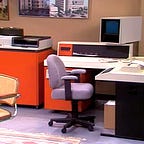Microcosms #3: On Flashlights, Corridors & Slow Ruin
Microcosms is an essay series that deals with games and art in both the direct and the abstract in 500 words or less.
Doom 3 is inseparable from its flashlight. Upon release, many were torn on the need to swap a weapon for a flashlight at key moments, and the more recent BFG edition attempted to fix that by mounting the flashlight on Doomguy’s shoulder. Some were happy, many weren’t. Videogames. This isn’t about that “controversy”, but rather about how important the flashlight is as a thematic device, and even more so, how I’ve come to believe that Doom 3 just might be my favorite Doom game.
The Mars of Doom 3 is not some far off planet but rather a claustrophobic maze of industrial corridors and metallic complexes that evoke a sense of all-consuming labor, consumption, and exploitation. Even Mars isn’t safe from the sharp, ever-turning gears of capitalism. The UAC is there doing something with science that is nefarious. As Doom fans, we are keyed into the dramatic irony of it all—at some point, demons will appear and thoroughly fuck everything up. And when those demons do arrive, the fall of Mars does not occur on a dime. The seams of reality slowly rip and tear—Hell doesn’t so much as consume Mars as it does rot it. The Hell of Doom 3 is like a fungus, slowly spreading and enveloping everything it touches. Both bodies and spaces give in to its demonic power. Audiologs build out the story that demonic worship and hell energy have been a known thing to the UAC and the Mars Complex. Workers at the lowest levels have gone missing, scientists have gone mad, but industry pushes ever onward. Soldiers become zombified, moaning husks and various demons of all shapes and sizes run amok through the endless maze-like hallways. Every dark corner has become familiar with the red glow of Hell.
Such darkness consumes Doom 3. The Doom Marine’s flashlight is both a beacon and a compass. It draws monsters to the player but it always reveals the path forward, and that path is often obfuscated in dark, like really dark, lighting. Doom 3 is a very dark videogames; more literally than figuratively. Its story of demons and evil corporations is Mature but it lacks the substance to genuinely be dark, but Doom 3 treats its lighting like a parlor trick. It is a haunted house experience with plasma rifles and demons. When darkness is literally everywhere and when reality itself becomes slippery, the power of light becomes almost sacred. But its revealing power is finite. The flashlight’s battery has to recharge, and in making such a necessary (and comfortable) mechanic finite, the player must pick and choose what areas are worthy of the grounding power of light, itself. Doom 3’s flashlight is fascinating in how necessary it is to the overall experience and how much it adds to both the games feel and visual flair—even today, Doom 3 is gorgeous.
Where many players see tension and annoyance in the flashlight, I see a mechanic that is beautifully necessary, and through the use of it, the tight corridors of Doom 3 open up. Corners no longer hide red eyes and haunted sounds, the flashlight shows what makes those sounds, and the Doom Marine eradicates the sounds at their source. With another demon now dead, the corner returns to just being a corner. Now, onto the next one.
